- HOME
- ABOUT US
- MUSEUMS
- VISIT
- GALLERY
- AUDIO GUIDE
- ETHNOGRAPHIC MUSEUM
- ONUFRI ICONOGRAPHIC MUSEUM GUIDE
- ONUFRI ICONOGRAPHIC MUSEUM GUIDE – OBJECT 2
- ONUFRI ICONOGRAPHIC MUSEUM GUIDE – OBJECT 3
- ONUFRI ICONOGRAPHIC MUSEUM GUIDE – OBJECT 4
- ONUFRI ICONOGRAPHIC MUSEUM GUIDE – OBJECT 5
- ONUFRI ICONOGRAPHIC MUSEUM GUIDE – OBJECT 6
- ONUFRI ICONOGRAPHIC MUSEUM GUIDE – OBJECT 7
- ONUFRI ICONOGRAPHIC MUSEUM GUIDE – OBJECT 8
- ONUFRI ICONOGRAPHIC MUSEUM GUIDE – OBJECT 9
- ONUFRI ICONOGRAPHIC MUSEUM GUIDE – OBJECT 10
- ONUFRI ICONOGRAPHIC MUSEUM GUIDE – OBJECT 11
- VIRTUAL TOUR
- CONTACT US
- HOME
- ABOUT US
- MUSEUMS
- VISIT
- GALLERY
- AUDIO GUIDE
- ETHNOGRAPHIC MUSEUM
- ONUFRI ICONOGRAPHIC MUSEUM GUIDE
- ONUFRI ICONOGRAPHIC MUSEUM GUIDE – OBJECT 2
- ONUFRI ICONOGRAPHIC MUSEUM GUIDE – OBJECT 3
- ONUFRI ICONOGRAPHIC MUSEUM GUIDE – OBJECT 4
- ONUFRI ICONOGRAPHIC MUSEUM GUIDE – OBJECT 5
- ONUFRI ICONOGRAPHIC MUSEUM GUIDE – OBJECT 6
- ONUFRI ICONOGRAPHIC MUSEUM GUIDE – OBJECT 7
- ONUFRI ICONOGRAPHIC MUSEUM GUIDE – OBJECT 8
- ONUFRI ICONOGRAPHIC MUSEUM GUIDE – OBJECT 9
- ONUFRI ICONOGRAPHIC MUSEUM GUIDE – OBJECT 10
- ONUFRI ICONOGRAPHIC MUSEUM GUIDE – OBJECT 11
- VIRTUAL TOUR
- CONTACT US
ONUFRI ICONOGRAPHIC MUSEUM

ONUFRI ICONOGRAPHIC MUSEUM

The Museum holds 200 artwork objects, icons and liturgical items dated from the 14th century to the 20th, brought together from several churches and monasteries of the region. You will see icons painted by renown Albanian icon painters such as Onufri, Onufri’s son Nikolla, Onufër the Cypriot, David Selenica, Kostandin Shpataraku, the Çetiri tribe with Gjergji, Johani, Nikolla, Naumi, and his son Gjergji, as well as anonymous painters. By their side, the liturgical items bear the signature of Albanian silversmiths of various times, and the Cathedral woodcarvings were crafted by masters Stefan Barka and Naum Ngjela, from Misrasi and Lavdari, in Opari, in the early 19th Century.

The iconostasis of the cathedral of the Dormition of St Mary was created in 1807. It is considered a finest piece of the Albanian woodcarving. The iconostasis decorations feature some Baroque-style features and principles, a dominant and distinctive trend of churches built in the Balkans during the 18th and 19th centuries. All these motifs are intertwined with other elements of Byzantine tradition.
In a wooden arch near Iconostasis are preserved the remains or relics of two Saints Gorazdi and Angjellari (disciples of Saints Metodi and Kirili) who are thought to have accomplished their mission in the 9th century AD.

The Purple Codex of Berat and the Golden Codex of Anthimos were discovered beneath the apse floor on August 12th, 1968 inside a small metal box hidden in the crypt.They are also known as the “Codex Purpureus Beratinus” from the 6th century A.D, and the “Codex Aureus Anthimi” from the 9th century A.D, or as the Codices of Berat. They are monuments of culture and civilization, and genuine encyclopedias of the Christian thinking.The two Berat Codices are listed in the list of humanity’s most important works, known as “Memoire du Monde” under the protection of UNESCO.
Onufri Iconographic Museum Collection
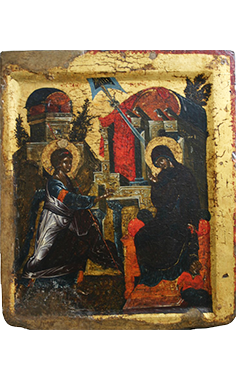
Evangelism
“Evangelism” XIV-XV cent anonymus. The Icon is taken from “Evangelism” Church in Berat castle and it displays the scene of Mary’s Annunciation from Archangel Gabriel, framed by architecture and landscape.

Last Supper
The "Last Supper" icon is a late 18th-century work by anonymous authors. The work was taken by the iconostasis of the Church of the Saint Mary’s Brith in the village of Vokopol, Berat.
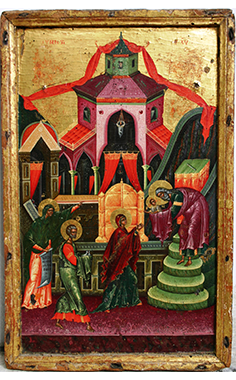
Jesus Appearance in Temple
“Jesus Appearance in Temple” XVI cent, Onufri The Icon is taken from “Saint Trinity” Church in Berat Castle. The whole scene in expressed in the colors kontrast, especially in the famous red kolor of Onufri.
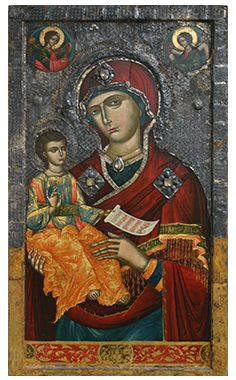
Saint Mary with Jesus
“Saint Mary with Jesus” XVI, Onufri. The Icon Belongs to the “Assumption of Saint Mary” Cathedral and displays Saint Mary with Jesus on the right, where are expressly distinguished the elegance and expressive colors of Onufri’s finely hand.
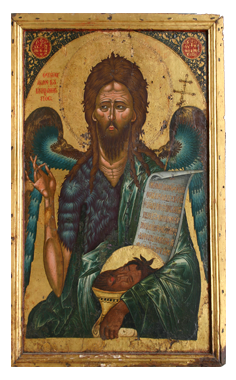
Johan the Baptist
“Johan the Baptist” XVI cent, Onufri. The Icon is taken from “Evangelism” Church in Berat Castle. It’s a display of Onufri’s colors’ kontrast, within a golden background, stylized with flora motives.
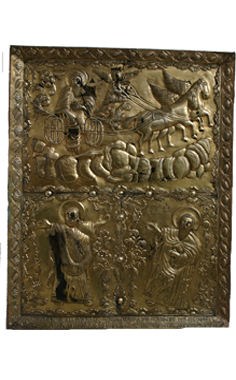
Ascension of Elijah Prophet
“Ascension of Elijah Prophet” year 1929 , Agathangjel Mbrica . The icon is taken from the silversmith’s collection in “Perroi” neighborhood of Berat and is masterfully realized with a finely technique.

Life giving source
“Life giving source” XVIII cent anonymous. The icon is taken from “Saint Elijah” church in Berat and belongs to modern and liberal iconography, where are combined the elements of different religions

Saint Demetrius
“Saint Demetrius” XVIII cent, Kostandin Shpataraku. The Icon is taken from “Elijah Prophet” of Berat and it represents modern elements in its style such as expressive silhouette, sharp contrasts and colors’ play
© 2020. All rights reserved
Design & Development by GO DIGITAL MEDIA


